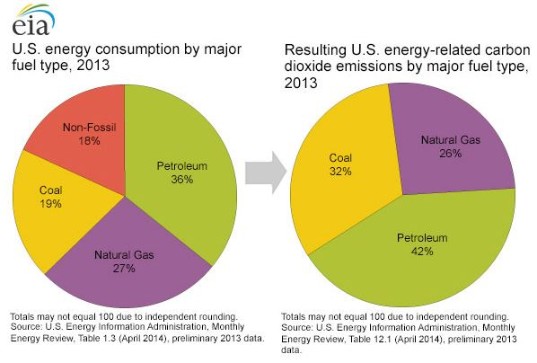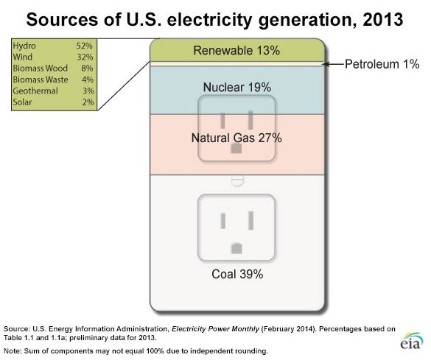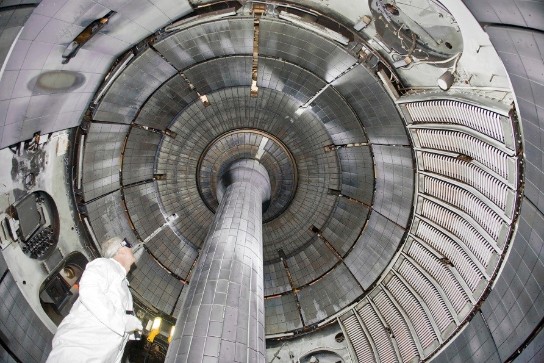Climate change has deep implications for energy policy
 The fossil fuels the United States uses to produce 83% of its energy are the main drivers of climate change. Any plan that looks to reduce emissions will require either reducing the total amount of energy produced (either through gains in efficiency, or absolute declines in energy used) or replacing a large portion of energy production with emissions-free power.
The fossil fuels the United States uses to produce 83% of its energy are the main drivers of climate change. Any plan that looks to reduce emissions will require either reducing the total amount of energy produced (either through gains in efficiency, or absolute declines in energy used) or replacing a large portion of energy production with emissions-free power.
An energy source should be defined as environmentally sustainable if the production and use of it does not cause undue harm. Whether that harm is to local ecosystems, the global atmosphere, water systems, neighboring businesses, or human health, an energy source with substantial externalities is not sustainable over the long term.
Environmental sustainability in energy generation and extraction are critical to the feasibility of any energy system.
America’s Energy Sustainability Profile
 Oil
Oil
Greenhouse gas emissions from oil and petroleum products, at 42%, are the single largest source of carbon emissions in the U.S.
While producing oil domestically is good for economic stability, drilling for oil can produce oil spills, like the explosion of the Deepwater Horizon platform in 2010 which killed 11 workers, shut down fishing across the Gulf of Mexico, and has cost more than $20 billion to clean up.
As exploration for oil expands into more difficult-to-access areas, such as deep underwater, in the Arctic and in the oil sands of Alberta, Canada, it is clear that there will be a greater risk of environmentally damaging spills due to the technical complexity of operating in these areas. Photo courtesy: L.C. Nøttaasen.
 Coal
Coal
Burning coal is the worst option for greenhouse gas emissions, producing 208,000 pounds of carbon dioxide per billion British thermal units (btu) output and 32% of CO2 emissions in 2013. Coal also contains pollutants, including mercury, lead, and sulfur.
Pilot projects in Norway and Germany are testing carbon capture and sequestration (CCS) technology as a way to remove greenhouse gas emissions and sequester them underground. They have not yet demonstrated that this is a safe, long-term option.
Coal mining remains the 7th most dangerous job in the country. Mining releases toxic sulfuric acid into local groundwater supplies, destroys local ecosystems, and harms human health. Greater environmental regulations and the increasing use of coal from Wyoming’s Powder River Basin, which has less average sulfur content than Eastern coal, mean that these new coal power plants do not emit as many acid-rain causing pollutants.
 Natural Gas
Natural Gas
Natural gas burns cleaner than other fossil fuels and contains fewer pollutants. Its greenhouse gas emissions are 117,000 pounds of carbon dioxide per billion btu; 44% lower than coal and 30% lower than oil. This means that if all electricity production currently using coal now were switched to gas, total U.S. greenhouse gas emissions would be about 10% less. In 2013, natural gas contributed to 26% of CO2 emissions. Photos: Consumers Energy
A “Bridge Fuel” to Renewable Power
Renewable generation is by its nature variable, so it’s important to have a ready reserve of reliable power for times when demand exceeds supply. Modern natural gas power plants are able to economically turn on and off, unlike coal or nuclear plants that require long lead times to heat up and cool off. For these reasons, natural gas has been called a “bridge fuel” to enable greater use of renewable power in the grid.
Although burning natural gas is relatively clean, there is an ongoing debate about how dangerous the mining of gas is for local air and water supplies. Hydraulic fracturing requires that large amounts of water and chemicals be injected deep into the earth at high pressures. There is a justifiable fear, and some evidence, that the chemicals in the fracturing will leach into water supplies. Properly done, the chemicals should not go into the water supply because the fracturing takes place far below the water table. In addition to potential water contamination, fracking requires large amounts of water, increasing water scarcity in areas already under water stress.
 Nuclear Fission
Nuclear Fission
Nuclear power, both from fission and fusion, does not produce greenhouse gases. If the U.S. produced the same percentage of its electricity from nuclear power as France does (77%), it would produce 19% fewer greenhouse gases.
Although there are no polluting emissions from existing (fission) nuclear power, that does not make it completely clean. Spent nuclear fuel, which can consist of radioactive uranium, plutonium, or thorium, presents long-term threats from radiation contamination. After spent nuclear fuel is removed from the reactor, it is placed in temporary water cooling pools within the reactor facility. This was not intended to be permanent, but the government’s failure to find a long-term strategy for storing spent nuclear fuel means that most of America’s radioactive spent fuel – 63,000 tons of nuclear waste – is stored on-site.
 Nuclear Fusion
Nuclear Fusion
Developing fusion may actually help to solve the problem of spent nuclear fuel from existing power plants. Physicists at the University of Texas at Austin have designed a new system that, when fully developed, would use fusion to eliminate most of the waste produced by fission nuclear power plants.
Pairing fission and fusion reactions would also allow the dangerous radiation to be absorbed by fusion reactions, thereby using the harmful radiation from fission reactions to power fusion reactions. In this way, fusion could help the long-term environmental sustainability of existing U.S. nuclear power plants.
Fusion is becoming a global imperative, with laboratories in the U.S., including the Princeton Plasma Physics laboratory, emerging as fusion leaders.
Read more about fusion energy here.
 Renewable Power
Renewable Power
In general, renewable power produces no greenhouse gas emissions. However, that does not mean that they are without environmental controversy.
America’s ethanol program, for example, is coming under intense – and justified – scrutiny. There are significant questions about the lifecycle emissions of ethanol. Even though it comes from plants, heavy inputs of fertilizer and use of fossil fuels to produce and transport it mean that the minimal benefit in reduced greenhouse gas emissions may not be worth the subsidies ethanol production receives.
The main environmental problems with renewable power come from the size of its footprint and its impacts on local wildlife and ecosystems. The Grand Coulee Dam, for example, flooded a 125 square mile area, displacing thousands and permanently ending the annual salmon run up the Colombia River. Large solar power plants planned for the California deserts are currently coming up against opposition from environmentalists who want to protect endangered wildlife from human encroachment.

 The fossil fuels the United States uses to produce 83% of its energy are the main drivers of climate change. Any plan that looks to reduce emissions will require either reducing the total amount of energy produced (either through gains in efficiency, or absolute declines in energy used) or replacing a large portion of energy production with emissions-free power.
The fossil fuels the United States uses to produce 83% of its energy are the main drivers of climate change. Any plan that looks to reduce emissions will require either reducing the total amount of energy produced (either through gains in efficiency, or absolute declines in energy used) or replacing a large portion of energy production with emissions-free power. Oil
Oil Coal
Coal Natural Gas
Natural Gas Nuclear Fission
Nuclear Fission Nuclear Fusion
Nuclear Fusion Renewable Power
Renewable Power



